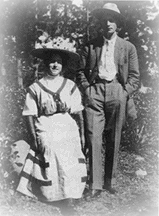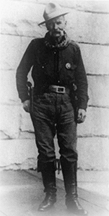The Watson Cabin Museum
Tahoe City, California

The picturesque log cabin which sits on the bluff overlooking the Tahoe
Commons was built by Robert Montgomery Watson in 1908 as a wedding gift for
his youngest son, Robert H. Watson and his new bride, Stella Tong. The
elder Watson, who was then the local Constable, had come to Tahoe City in
1875 from Bradford County, Pennsylvania, by way of Foresthill in Placer
County, where he had met and married Sarah Cunningham, a native of Maine.
In 1887, Watson and his wife leased the Tahoe House, a popular wayside inn,
and for the next decade they ran this establishment together. During this
period, the Watsons had five children: Alice May, Edna Nevada, Herbert
Sydney (Bert), Francis Gilbert (Frank) and Robert Howard (Rob).
In 1897, Watson found himself lured by the call of the Klondike gold rush,
and with his oldest son Frank, who was then 14, he set out to gain his
fortune in the Yukon gold fields, leaving the remaining family members to
operate their Tahoe City business. On Watson's return to Tahoe City in
1900, son Frank remained behind to work their mining claim.
Soon thereafter, Watson built another log structure in Tahoe City, to be
occupied by the resident Gatekeeper who tended the dam which controls the
flow of water down the Truckee River. Though this building was later
destroyed by fire, its replica stands on the site, on the south bank of the
river, and is today the Gatekeeper's Cabin Museum, open to the public from
May through September.
 On his return from a second trip to the Yukon in 1904, Watson was appointed
the Tahoe area's first Constable, an office he held for the next 28 years,
supplementing this livelihood with work as a guide, mill operator and
trailfinder. Watson was among the town's most revered citizens, and was
fondly known as "Grandpa" by all the local youngsters. It was said that
there was no horse in the area which would fail to answer his beckoning
whistle, and every dog in town knew his friendly pat.
On his return from a second trip to the Yukon in 1904, Watson was appointed
the Tahoe area's first Constable, an office he held for the next 28 years,
supplementing this livelihood with work as a guide, mill operator and
trailfinder. Watson was among the town's most revered citizens, and was
fondly known as "Grandpa" by all the local youngsters. It was said that
there was no horse in the area which would fail to answer his beckoning
whistle, and every dog in town knew his friendly pat.
In the last years of his life, Watson devoted himself to the marking of
early trails in the region, and in 1930, accompanied by his faithful army
horse Brownie, he traced one major route taken by California's early
settlers, building a stone monument just west of the head of Squaw Valley,
which he dedicated to the many pioneers who had helped to settle the west
as well as to those men who had served their country in the first World
War.
Watson's youngest son Rob, for whom the cabin was built, was born in 1886
in San Francisco. He was a student at the first school in Tahoe City, which
had been built by his father, and later attended Oakland Technical School.
When Rob married Stella Tong in 1909, the couple moved into the little log
house on the bluff, and Rob became involved in the local building trades,
constructing many piers and breakwaters along the west shore of the Lake.
Stella Tong was born in 1890 in Clarksville (14 miles west of Placerville),
and had come to know Tahoe at an early age. Two of her sisters had married
two brothers of the Scott family, who owned Deer Park Springs (now the site
of the River Ranch at the entrance to Alpine Meadows), and for years her
brother Wert managed the Tahoe Inn. Stella drove the Tahoe school bus for
many years, and was a devoted friend to local school children.
The Watsons' daughter Mildred was born in 1910, and the family continued to
occupy their log residence each summer. They did spend several winters in
the little log cabin, but found it too cold and isolated for their liking,
eventually relocating to the Foresthill area when the first snows arrived,
returning each summer to operate a lumber company on Front Street (Hwy. 28)
purchased from Walter Bickford in 1920.
 By the mid-1920s, the family had begun to find the traffic and noise of
Tahoe City's downtown intolerable, and in 1926, they bought several hundred
acres of land northeast of Burton Creek, where they established a sawmill.
Thereafter, the family lived on this property in the summer, spending their
winters in Gold Hill, in western Placer County.
By the mid-1920s, the family had begun to find the traffic and noise of
Tahoe City's downtown intolerable, and in 1926, they bought several hundred
acres of land northeast of Burton Creek, where they established a sawmill.
Thereafter, the family lived on this property in the summer, spending their
winters in Gold Hill, in western Placer County.
In 1947, the Watsons leased their log cabin to E.P. "Husky" and Fern Hunt,
who operated it as a gift shop each summer through 1976. The Hunts sold
gifts from around the world, including a renown collection of Navajo Indian
rugs.
From 1976 until 1990, Betty Layton and her daughter Judy leased the
property, selling handcrafted pottery, Navajo rugs and Mrs. Layton's
watercolors under the name of The Potter's Wheel.
The North Lake Tahoe Historical Society and the Tahoe City P.U.D. were able
to purchase the property in 1979, and it is now listed in the National
Register of Historic Sites as the oldest home, built on-site, in Tahoe
City. It also claims the town's first private indoor bathroom, and is
certainly among the area's most picturesque residences, with its chinked
log construction and sweeping Lake vista.
Admission to the Museum is free, however donations are gratefully accepted to aid
in the restoration and preservation of the Watson Cabin.
Open from noon to 4 p.m. daily from June 15 through Labor Day
Watson Cabin Museum
560 North Lake Blvd.
Tahoe City, CA 96145-6141
(530) 583-8717
nlths@tahoecountry.com
North Lake Tahoe Historical Society | Gatekeeper's
Museum | Watson Cabin
Indian Basket Museum | Membership
Information
Site donated by Tahoe Country
Shop our Tahoe Country Store Online

Or visit our store in Heavenly Village, South Lake Tahoe. (map)
 On his return from a second trip to the Yukon in 1904, Watson was appointed
the Tahoe area's first Constable, an office he held for the next 28 years,
supplementing this livelihood with work as a guide, mill operator and
trailfinder. Watson was among the town's most revered citizens, and was
fondly known as "Grandpa" by all the local youngsters. It was said that
there was no horse in the area which would fail to answer his beckoning
whistle, and every dog in town knew his friendly pat.
On his return from a second trip to the Yukon in 1904, Watson was appointed
the Tahoe area's first Constable, an office he held for the next 28 years,
supplementing this livelihood with work as a guide, mill operator and
trailfinder. Watson was among the town's most revered citizens, and was
fondly known as "Grandpa" by all the local youngsters. It was said that
there was no horse in the area which would fail to answer his beckoning
whistle, and every dog in town knew his friendly pat.
 By the mid-1920s, the family had begun to find the traffic and noise of
Tahoe City's downtown intolerable, and in 1926, they bought several hundred
acres of land northeast of Burton Creek, where they established a sawmill.
Thereafter, the family lived on this property in the summer, spending their
winters in Gold Hill, in western Placer County.
By the mid-1920s, the family had begun to find the traffic and noise of
Tahoe City's downtown intolerable, and in 1926, they bought several hundred
acres of land northeast of Burton Creek, where they established a sawmill.
Thereafter, the family lived on this property in the summer, spending their
winters in Gold Hill, in western Placer County.